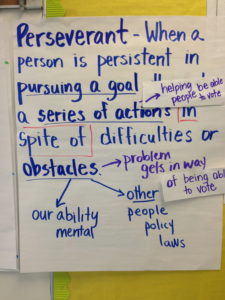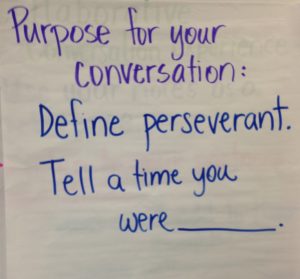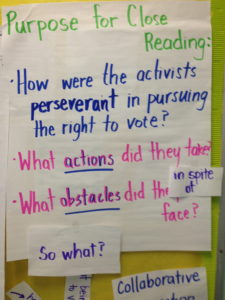
Lesson Experience – Even when definitions of vocabulary words are carefully planned for discussion during close reading, these definitions can be problematic…
In a blog entry from last December about a lesson experience, I discussed the needs of a specific group of 6th graders I worked with in an urban school. Many seemed to lack depth of understanding of key theme words used to make claims. I promised to blog later about the lesson specifically and failed to follow up – sorry! (Alas, where does time go?) So here it is.
I planned a lesson that would focus on understanding the term perseverant as it relates to the work of the social rights activists pursuing the right to vote – specifically in Selma, Alabama in the early 1960’s. My theory is that if students understand vocabulary words like “perseverant” in one context, they will be able to take that understanding and apply it to many, many other contexts they are reading about in nonfiction texts. Easy, right? Ha!
When I teach a word like perseverant, I start by asking myself what I know about this word. Actually, I just start by looking up the definition on-line. I never assume I know enough about a word to just start teaching. Just by looking up the definition, I gain more depth in my understanding of the word and my ability to articulate its meaning to students.
The online definition for “perseverant” is “to persevere.” Great. The definition of “persevere” is to persist in a state, enterprise, or undertaking in spite of counterinfluences, opposition, or discouragement (http://www.merriam-webster.com/dictionary/persevere). Okay. I can play around with this. Thinking about “kid-friendly” definitions, I came up with the following for “perseverant”:
When a person is persistent in pursuing a goal through a series of actions in spite of difficulties or obstacles.
Now, wait. Even with careful planning, this definition would prove to be problematic – but I wouldn’t know it until I was working closely with the students.
For close reading, I chose an excerpt from the award-winning Marching for Freedom: Walk Together Children and Don’t You Grow Weary by Elizabeth Partridge (about 190 words – two paragraphs total, p. 4 about the work of activist Sandra Boynton.) (LOVE THIS BOOK!!! Highly recommend for all 5-8th grade classroom libraries.)
At the beginning of the lesson, I read aloud the first chapter of Partridge’s book, placing the book on the document camera so the students could view the stunning photos Partridge included to support her points. As I posted each photo, I asked, “What do you notice? What makes you think so?” (10 minutes)
Then before we started close reading, I briefly defined and explained “perseverant.” This part of the lesson could take up the whole period, but I kept it short. I posted the definition (see image of anchor chart) for all students to see and I posted another piece of chart paper with the students’ purpose for conversation (see additional image below). I asked the students to turn and share a time they’d been perseverant. I pushed in and coached trios of students in sharing and then after a few minutes, I asked one student to join me at the front and share his example of perseverance. What I quickly noticed was their examples of perseverant were about overcoming inner-obstacles – learning to play basketball, run faster, do math. The excerpt I’d chosen and what I’d been thinking about were – external obstacles like government policies, or racists, or fear created by others as obstacles to the work of the activists. I needed to differentiate this for the students – internal and external obstacles.

So I went back to the anchor chart with the definition and added notes – look at the anchor chart again and notice the notes regarding “our ability” and “other.” Our purpose for close reading was – How were the activists perseverant in pursuing the right to vote? (See anchor chart below.) As we began the close reading and I gradually released control to partners to close reading, I noticed (while conferring) that some of the students did not know what “obstacles” meant. So I took advantage of another teachable moment and added “problem gets in the way” to the anchor chart with the definition. We worked forward in this manner – continuously referring to our definition to help us clarify what we were or were not understanding AND what we were learning in regards to the purpose for close reading.
I closed this lesson by asking the students to gather in a circle – with their notes. With a volunteer student, I modeled in the middle of the circle how to look at the annotations I’d written (and the volunteer had written) on the text excerpt (on the doc camera during close reading) and refer to the anchor chart with the definition of “perseverant” to discuss what I’d learned. Then I coached pairs of students when they turned to talk with a partner – using their notes and the anchor chart as references. They revealed some depth in their learning during their discussions with partners. Follow up instruction for a group like this would be to work with this key vocabulary word and others over time – with many different texts and in many different conversations.

This lesson experience has influenced many lessons I have given since then. I carefully craft definitions that are part of close reading prompts – to be rigorous and to present students with enough language to explain what they are learning during close reading. IN ADDITION, I observe and assess students’ understanding of the work and add to/revise the definition as needed. I blogged recently with some more examples of how I’ve done this. I really think this helps students explain evidence they are identifying related to the purpose for close reading.
A dear colleague reminded me that I had not followed up with a description of this lesson! Thanks, Tara!!!
Hope this helps.
